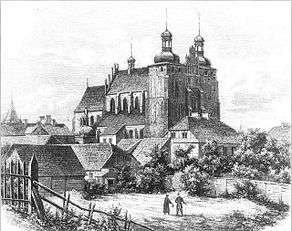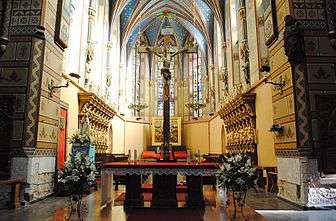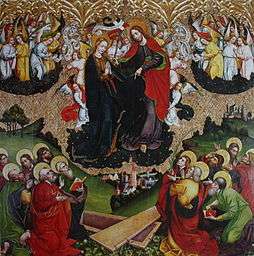Basilica Cathedral of St. Mary of the Assumption
 | |
| Country | Poland |
|---|---|
| Region | Wloclawek |
| Affiliation | Catholic |
| Style | Gothic, neo-Gothic |
| Address | Plac Kopernika 7 |
The Basilica Cathedral of St. Mary of the Assumption is a large Gothic building situated in the Polish city of Włocławek located near to the Vistula River. Construction on the cathedral began in the 1340s, and it was consecrated in 1411. It was still under construction in the 15th and at the beginning of the 16th century, until its completion in 1526. It is one of the greatest treasure troves of funerary art in Poland next to the cathedrals in Gniezno, Poznan and Cracow.
Background information and the history of the cathedral
The first places of worship in Wloclawek
When Wloclawek became a bishopric, there may already have been two places of worship in the city. One of them was probably a castle chapel, and the other was St. John the Baptist Church with which the parish functioned that was administered then by Benedictines. The castle chapel, which was under the auspices of the prince, played the role of the first cathedral. According to the chronicler Jan Dlugosz, bishop Swidger (around 1133) equipped the new cathedral in Wloclawek, and adapted the castle chapel which was dedicated to St. Mary of the Assumption. However, the first written information about the cathedral in Wloclawek comes only from 1185.
Because of its location the cathedral often suffered damage. The waters of the Vistula River, and fires also contributed to its destruction, which finally led to the building of a new cathedral under the guidance of the bishop Michal Godziemba (1222-1252). He decided to set up the new cathedral in place of the first cathedral. It is not known for certain when this second cathedral was set up. It was probably a three-aisle building made of stone in the Romanesque style with a wooden ceiling. It lasted until 1329 when the Teutonic Knights destroyed it.

Research into the history of the first cathedrals in Wloclawek is as yet incomplete. It requires further investigation and excavations. The situation is slightly better when it comes to the third – still extant– basilica cathedral.[1]
The current cathedral
The history of the cathedral of St. Mary of the Assumption begins during the episcopate of Bishop Maciej of Golancz (1323-1364). He was a canon of Wloclawek, Gniezno, Poznan, Plock, Cracow, and Wroclaw. Maciej was the first initiator and the builder of the cathedral.
On 7 May 1329 Teutonic troops captured Wloclawek, and destroyed the borough, concentrating in particular on the bishop’s property. The Teutonic Knights forbade restoring the bishop’s town and the cathedral on pain of death.
On 24 August 1330 Maciej of Golancz decided to sign a pact with the Grand Master of the Teutonic Knights, Werner von Orseln, who allowed him to resume public religious activities. To this end, a small church beyond the city was built as a temporary solution. But Maciej Golanczewski still wanted to build a cathedral, and collected funds and created plans to do so. On 25 March 1340 he consecrated the cornerstone to begin building the new cathedral. During the next 25 years, the construction on the walls of the cathedral was ongoing; Maciej’s nephew - Zbylut (1365-1383) succeeded to the bishopric, and continued building the cathedral. The details of the construction process are uncertain. The first stage, including the presbytery, southern vestry and treasury, were most likely completed under the guidance of Maciej Golanczewski. During Zbylut’s incubency in the diocese the roofs of the lofts and vestry were finished, and the high altar with the figure of the Mother of God was set up.

Changes made to the cathedral
On 13 May 1411 a ceremonious consecration of the cathedral attended by the king of Poland Wladyslaw Jagiello took place. But the cathedral was not yet finished. Construction continued over the course of the next centuries. There are mentions that prelates and canons of the chapter in Wloclawek gave up part of their income for the further building and conservation of the cathedral.[2] In the second part of the15th century work was started on the chapels around the main body of the church.[3] Next to the southern nave, St. Martin's Chapel and chapterhouse were built in 1527 and the Cibavit chapel in 1541. At the beginning of the 16th century these two chapels were remodelled in the Mannerist style which included covering them with cupolas with lanterns. Over time, the cathedral needed renovation. In the second part of the 18th century the roof was renovated[4] while in the 19th century the cathedral was regothicised. The bishop Wincenty Teofil Chosciak wanted the cathedral to look more monumental and decided to enlarge the towers. The works began in 1878. They enlarged the towers, and finished them off with pointed cupolas.
In 1907 the cathedral was honoured with the title of minor basilica. The title was given by the Pope Pius X.
An important event in the history of the cathedral was the visit of Pope John Paul II, who stayed in Wloclawek on 6 and 7 June 1991 during his fourth journey to his home country.[5]
The cathedral as a treasure trove of art
The three-aisle interior is maintained in the gothic style, but has baroque and neo-Gothic elements in it. The cathedral contains some great pieces of art from different centuries, including the following:
- The tomb of Piotr of Bnin Moszczynski, dating from about 1496, funded by Kallimach and made by the famous sculptor Veit Stoss. It is now located in St. Joseph’s chapel.Examples of Renaissance art such as the tombstone of bishop Krzeslaw Kurozwecki made of marble in 1516 and the tombstone of bishop Jan Karnkowski made in 1536
 The presbytery in the cathedral
The presbytery in the cathedral - Wooden sculptures of the Mother of God from the beginning of the 15th century and a polychrome group of the Last Supper from 1505
- An early baroque sepulchral memorial of two bishops Pstrokonski and Lubienski from 1629 by Augustin von Oyen. It was made of multicolour marble and alabaster, and is situated in the eastern Manneristic niche. In the entrance of the niche, there is a great portal from 17th century
- Gothic stained glass from about 1360 made probably in Toruń and funded by the bishop Zbylut Golanczewski
- Art Nouveau stained glass designed by Jozef Mehoffer made in 1938/1939
- Assumption of the Blessed Virgin Mary – a picture dating to around 1475 ascribed to Francis of Sieradz
- The Assumption of St. Mary by Jan Wielki from 1480[6]Stained glass in the Basilica Cathedral

The organization of the church
In 2015 Michal Krygier became the new parish priest.
Paweł Skowron - vicar
Sebastian Adamczyk - vicar
The choir
When the orchestra which had functioned in the cathedral since the 18th century closed down, the priest Leon Moczyński formed a choir out of seminarians. After some time, some people from the city expressed willingness to join in. Therefore, the cathedral had two choirs – the one formed by priests, and the mixed one formed by lay boys and men. They often performed together as cathedral choirs.
In 1925 part of the choir broke away from the cathedral and became the Association of Former Cathedral Choirs “Lute” (Lutnia) (which still exists today). The priest Andrzej Nodzynski reformed the cathedral choir and continued to work with it.
In 1938 Tadeusz Guzenda became the conductor of the choir. In the 60s he formed, alongside the male choir, a female one. When the priest Zbigniew Szygenda was conductor, he united both choirs. Since 1983 Jozef Nowak has been the conductor of the choir that consists of 45 people.[7]
Masses and sightseeing
- Monday: 7am Mass; 4pm Benediction and the Bead-roll and litany to St. Joseph 6pm Mass
- Tuesday: 7am Mass; 4pm Benediction and service to Blessed Bishop Michal Kozal, the patron of Wloclawek 6pm Mass
- Wednesday: 7am Mass; 4pm Benediction and Novena to Our Lady of Perpetual Help 6pm Mass
- Thursday: 7am Mass; 4pm Benediction and the Prayer for priestly vocation through the intercession of John Paul II 6pm Mass
- Friday: 7am Mass; 4pm Benediction and Chaplet of the Divine Mercy 6pm Mass
- Saturday: 7am Mass; 6pm Mass
- Sunday: 7am Mass; 8am Mass; 9.30am Mass; 11am Mass; with children and youth; 12.30pm Mass; 6pm Mass[8]
There is an option to tour the cathedral with a guide on the following days: Tuesday: 9am-3pm; Wednesday and Thursday: 10am-4pm; Friday: 9am-3pm, Saturday: 9am-2pm. The cost of the tour for the entire group is 30 PLN.[9]

References
- ↑ "Cathedral parish in Wloclawek (Parafia Katedralna we Włocławku)". www.katedrawloclawek.pl. Retrieved 2016-02-14.
- ↑ "Parafia Katedralna we Włocławku". www.katedrawloclawek.pl. Retrieved 2016-05-20.
- ↑ "Parafia Katedralna we Włocławku". www.katedrawloclawek.pl. Retrieved 2016-02-14.
- ↑ Sikorska, Anna. "Katedra p.w. Wniebowzięcia NMP we Włocławku". www.odznaka.kuj-pom.bydgoszcz.pttk.pl. Retrieved 2016-02-14.
- ↑ "Parafia Katedralna we Włocławku". www.katedrawloclawek.pl. Retrieved 2016-05-20.
- ↑ "Koło Naukowe Historyków przy Z. S. Samochodowych im. T. Kościuszki we Włocławku - informacje". www.knh.wwi.pl. Retrieved 2016-02-14.
- ↑ "Parafia Katedralna we Włocławku". www.katedrawloclawek.pl. Retrieved 2016-02-14.
- ↑ "Parafia Katedralna we Włocławku". www.katedrawloclawek.pl. Retrieved 2016-02-14.
- ↑ "Muzeum Diecezjalne we Włocławku". muzeum.diecezja.wloclawek.pl. Retrieved 2016-02-14.
Coordinates: 52°39′40″N 19°04′05″E / 52.661°N 19.068°E